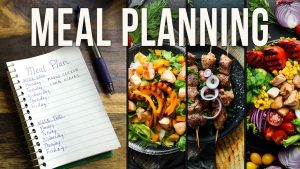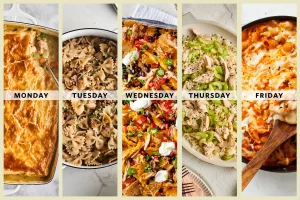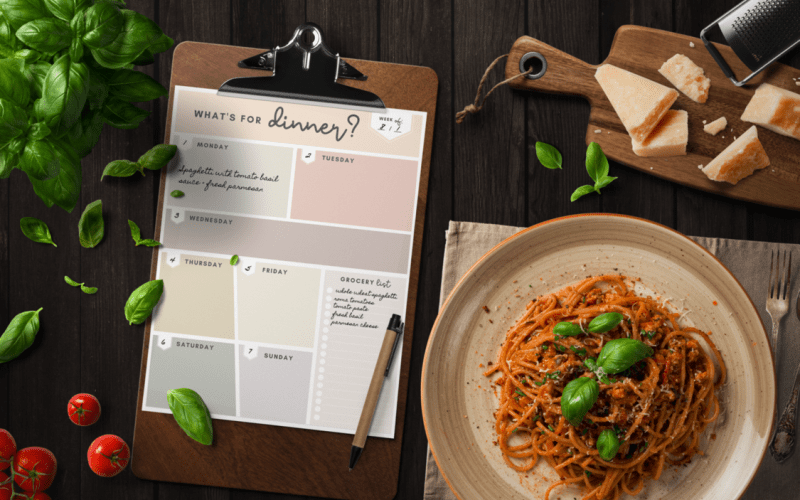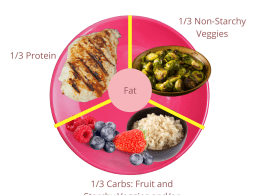Introduction
In today’s busy world, figuring out what to cook every day can be stressful. Without a plan, you may end up making last-minute trips to the store, ordering expensive takeout, or throwing away food. Meal planning can help you save time, reduce stress, cut down on food waste, and enjoy healthy, homemade meals.
Planning your meals for the week will help you stay organized, save money, and make sure you are eating healthy meals that everyone in your family will enjoy. Whether you need easy dinners, meal prep ideas, or tips for saving money, this guide will help you every step of the way.
What is Weekly Meal Planning and Why is it Important?

What is Meal Planning?
Weekly meal planning means picking your meals for the week, making a grocery list, and getting everything ready so that cooking is easier. It helps you eat healthier, save time, and save money.
Why Should You Plan Meals?
- Save Time: No more last-minute decisions about what to eat.
- Waste Less Food: Use all the food you buy.
- Save Money: Avoid buying things you don’t need or ordering takeout.
- Eat Healthier: You can make balanced meals with good ingredients.
- Make Shopping Easier: You’ll know exactly what to buy.
Having a meal plan makes it easier to enjoy family meals and avoid stress.
Simple Steps to Plan Your Family’s Weekly Menu

1. How to Plan a Weekly Menu for Your Family
Step 1: Think About Your Family’s Needs
Before planning meals, think about your family’s daily schedule and what everyone likes to eat. Busy evenings might need fast meals, while weekends can be for bigger dinners.
Step 2: Plan Balanced Meals
Make sure your meal plan includes a variety of foods like protein (meat, beans, etc.), vegetables, grains (rice, pasta), and healthy fats (olive oil, nuts). This keeps everyone healthy and full of energy.
Step 3: Pick a Theme for Each Day
Making a theme for each day can help you choose meals quickly. Some ideas are:
- Meatless Monday: A plant-based meal like veggie stir-fry.
- Taco Tuesday: Tacos with different fillings.
- Slow Cooker Wednesday: A meal you can cook in a slow cooker like stew.
- Pasta Thursday: Pasta dishes like spaghetti or pasta salad.
- Pizza Friday: Homemade pizza.
- Soup and Sandwich Saturday: A soup and sandwich meal.
- Family Favorites Sunday: Meals everyone loves.
These themes keep things fresh and easy.
2. Shopping Smart for Your Meal Plan
Step 1: Make a Grocery List
Once you’ve planned your meals, write down everything you need to buy. Organize your list into categories like fruits, veggies, meats, and pantry items.
Step 2: Stick to a Budget
Look for deals, buy in-season items, and consider buying in bulk to save money. Plan meals around cheaper items like beans, lentils, and eggs.
Step 3: Keep Essentials Stocked
Have basic items on hand, like pasta, rice, canned beans, and frozen vegetables. This makes meal prep easier.
3. Meal Prep Tips for Busy Families
Step 1: Prepare Ingredients Ahead of Time
Wash, chop, and portion ingredients before the week starts. This saves time when cooking later.
Step 2: Cook More, Eat More
Make extra portions of meals like soups or casseroles. You can eat them later or use leftovers in new meals.
Step 3: Use Time-Saving Tools
Things like a slow cooker, Instant Pot, or air fryer can help you cook faster.
Step 4: Use Leftovers
Turn leftovers into new meals. For example, use leftover chicken in a salad, sandwich, or pasta dish.
4. Making Meal Planning Fun and Easy for Kids
Step 1: Involve the Family
Let your family help pick meals or even help with cooking. It makes mealtime more fun.
Step 2: Keep Meals Flexible
Choose meals where you can easily change ingredients. If you don’t have one item, you can swap it with something else.
Step 3: Make Meals Kid-Friendly
For picky eaters, let them add their own toppings or dips to the meal.
Step 4: Have Quick Meals Ready
Keep frozen veggies, pre-cooked rice, and canned beans on hand for busy days.
How to Organize Your Weekly Menu
Organizing your weekly menu doesn’t have to be complicated. Write down the meals for each day of the week. For example, you might plan spaghetti on Monday, tacos on Tuesday, and chicken stir fry on Wednesday. You can use a calendar or just a notebook to keep track of your plan. The important thing is to have a clear idea of what to make each day. You don’t need to plan every meal down to the smallest detail, but having a general idea helps a lot.
Adjusting Plans as Needed
Life can be unpredictable, so it’s okay to adjust your meal plan when necessary. If something unexpected comes up, such as a change in your schedule or your family’s mood, feel free to swap meals around. The goal of meal planning is to make your life easier, so if something isn’t working, don’t be afraid to change it. Flexibility will help you stay on track while making meal planning stress-free.
Choosing Family-Friendly Recipes

When meal planning, it’s important to choose recipes that your whole family will enjoy. Think about everyone’s preferences and try to include meals that are both tasty and nutritious. If you have picky eaters, try making meals that can be customized. For example, cookies, tacos or sandwiches can have different toppings, allowing each person to add what they like. This makes mealtime easier and everyone feels included.
Staying Organized
The key to meal planning is staying organized. Make sure your meal plan, shopping list, and recipes are easy to access. You can keep everything in a notebook, a digital file, or an app that you can update and review. When your meal plan is organized, it’s easier to stick to it, and it saves you time when you’re planning for the week ahead.
Challenges of Meal Planning
Despite its advantages, meal planning can come with challenges. It requires time and effort to plan meals and create a shopping list. Some families may also struggle with sticking to their plan, especially when unexpected events or cravings arise. Additionally, meal planning may feel overwhelming for beginners, especially if they are new to organizing their meals.
The Future of Meal Planning

The future of meal planning looks bright as technology continues to make it easier. Meal planning apps, grocery delivery services, and online recipes are all making it more convenient for families to plan meals. As more people embrace the benefits of meal planning, it is expected to become a regular part of family life for many.
Sample Weekly Meal Plan for a Family
| Day | Meal Theme | Example Dish |
|---|---|---|
| Monday | Meatless Monday | Chickpea curry with rice |
| Tuesday | Taco Tuesday | Chicken tacos with salsa |
| Wednesday | Slow Cooker Meals | Beef stew with potatoes |
| Thursday | Pasta Night | Garlic shrimp pasta |
| Friday | Pizza Night | Homemade veggie pizza |
| Saturday | Soup & Sandwich | Tomato soup with grilled cheese |
| Sunday | Family Favorites | Roast chicken with mashed potatoes |
This simple plan gives your family variety while making meals easy to prepare.
Conclusion
Meal planning can be simple. By picking a theme for each day, making a shopping list, and prepping ahead of time, you can reduce stress and enjoy home-cooked meals.
Conclusion
Planning your family’s weekly menu doesn’t have to be difficult. Meal planning can be simple by picking a theme for each day, making a shopping list, and prepping ahead of time, you can reduce stress and enjoy home-cooked meals. Whether you prefer traditional meal planning, batch cooking, or getting the whole family involved, there’s a method that works for you. With just a little effort, you’ll have healthy, budget-friendly meals ready to go for the entire week.












